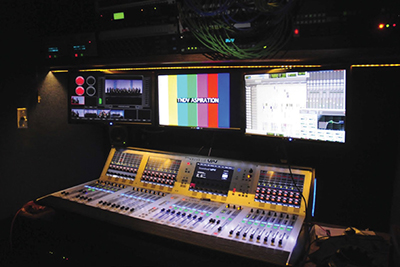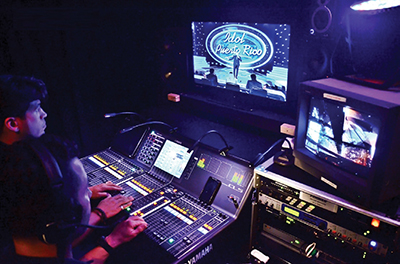Fiber Boosts Audio Network Capabilities
LOS ANGELES—While easy interoperability between the numerous digital audio networking and transport schemes currently on the market remains a barrier to their wider adoption, there are significant benefits when implemented within a closed ecosystem such as a remote production truck or a television broadcast plant.

Nashville-based TNDV has installed the Soundcraft Vi4 console in its Aspiration OB truck. The professional, consumer, and automotive AV industry has been working hard to develop a technical standard—AVB, or Audio Video Bridging—that will enable the easy sharing of audio and video streams across a network of equipment from disparate manufacturers. But until AVB becomes standard on every piece of equipment, operators can benefit from the networking and transport capabilities already available on audio mixing console systems.
FIBER BENEFITS
Nick Dugger, president and owner of Emmy Award-winning TNDV, a Nashvillebased remote production company specializing in sports and entertainment broadcasts, noted that the networking capabilities of the Soundcraft Vi4 console in the company’s 40-foot Aspiration truck offers several benefits. At a sports event, he said, “Instead of running traditional DT12 analog multicable, we run a fiber line and use a digital stage box associated with the Vi4 console to get all of our IFB sends and our microphone returns from the talent booth.”
The fiber infrastructure and digital stagebox, part of the Soundcraft console and thus standard equipment on the truck, shortens setup time. “It’s not unusual to have a sports A2 show up, looking for a stack of DT12 mults and we hand them a light fiber cable,” said Dugger.
Adam Ellis, audio engineer for TNDV further noted, “What we end up doing is putting the digital stage box out there as a hub and branching off copper infrastructure from there. So you have one main trunk that hits the stage box, and from there you can run up to the press box, or wherever you need to go, using fan-to-fan DT. They’re shorter runs and an easier loadout, for sure.”

Ricky’s Audio Corp. of Arecibo, Puerto Rico, recently purchased a Yamaha CL5 digital audio console for use on the second season of “Idol Puerto Rico.” Ricky’s Audio Corp. of Arecibo, PR, recently purchased a Yamaha CL5 digital audio console for use on the second season of “Idol Puerto Rico,” part of the global “Idol” franchise. “[An] important factor in our decision to purchase the CL5 was the ability to use a normal Ethernet cable as a transport for the Dante network along with the flexibility this protocol has to offer,” said Néstor J. Heredia, executive vice president/electrical engineer, Ricky’s Audio Corp.
Yamaha supports what may be the widest range of digital transport protocols of any pro audio manufacturer via its interface cards: AVB, CobraNet, Audinate Dante and EtherSound versions, as well as Aviom A-Net, Optocore and Riedel RockNet. Heredia reported that, using his console’s Dante transport, he was able to provide a fiveway split to additional desks on one “Idol” episode. “That kind of a split with copper wire would have been possible, but costly,” he said, requiring numerous isolating transformers.
The professional video industry's #1 source for news, trends and product and tech information. Sign up below.
MORE CHANNELS, BETTER QUALITY
Audio quality is also improved over a digital network, Heredia commented, eliminating the grounding problems associated with copper. “We can carry lots of channels through that line for about 300 feet without any problem: transformerless power, uncompressed audio, and no loss over the cable,” he said.
The most common console system found on NEP’s massive fleet of trucks is Calrec. That manufacturer’s Hydra2 routing system allows multiple consoles and remote I/O boxes to be networked over fiber or copper.
“We use the remote boxes on auto racing to capture all the microphones around the race track, anywhere from eight to 12 boxes depending on the size of the course,” reported George Hoover, chief technology officer for NEP in Pittsburgh.
“These all connect back to the consoles via a fiber network we install at each track. In many cases, the actual wall boxes can be several miles away from the console itself. The ability to eliminate separate copper pairs for each mic channel, plus all the connections, along with the associated hum and noise over long copper runs, has been a significant improvement in audio quality and setup time. The ability to have remote gain control and phantom power is a big plus as well.”
At entertainment shows, Hoover continued, stage boxes can be dropped in the orchestra pit, front of house, apron and backstage. “Four fiber runs and we have pristine audio, and the benefit of comms and video on the extra fiber strands,” he said. “That’s very important when we need to be up and rehearsing in a couple of hours.”
Wheatstone Corp. has based its mid-market Dimension One console system on a rack-based digital network architecture, significantly streamlining the facility infrastructure and installation, whether it includes one console or many. A single Cat-5 cable connects the console surface to the network; patchbays are eliminated, since the network handles all routing; distribution amplifiers are now a thing of the past; and cable trays and troughs are no longer necessary. It’s a design philosophy the New Bern, N.C.-based company refers to as “Network First.”
“Network First’s design represents a profound shift in how audio is mixed,” said Andy Calvanese, vice president of engineering for Wheatstone, N.C.-based company. “Putting an audio network first is the only way to take full advantage of the performance potential of digital audio technology. Eventually, all audio mixing will be done this way.”
By putting the network at the center of the system, the console becomes just another node on that network. Other nodes might include another console surface, or I/O boxes, or additional DSP resources.
Logitek, too, offers networked console systems based upon its JetStream audio-over- IP platform. The company’s JetStream Mini console engine and IP networking platform supports up to 128 channels on a single AoIP node.
A recent addition to the Logitek product line, vMix Virtual Mixer software, which provides all of the features of a hardware control surface, demonstrates yet another benefit of a digital audio network. Where space is at a premium in a control room, or when used at a remote location, vMix enables a computer to control a Logitek digital audio system without the need for a physical control surface, or to emulate another physical control surface. The software is capable of simultaneously emulating up to three different hardware control surfaces.
Steve Harvey began writing for Pro Sound News and Surround Professional in 2000 and is currently senior content producer for Mix and a contributor to TV Tech. He has worked in the pro audio industry—as a touring musician, in live production, installed sound, and equipment sales and marketing—since November 1980.
